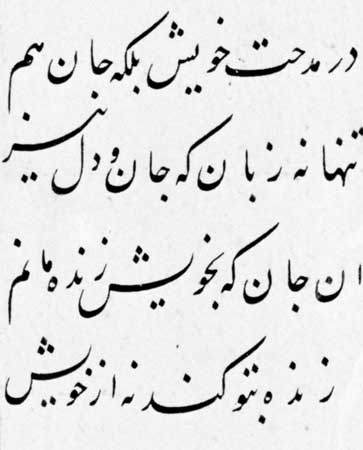nastaʿlīq script
calligraphy
predominant style of Persian calligraphy during the 15th and 16th centuries. The inventor was Mīr ʿAlī of Tabrīz (Mīr ʿAlī of Tabriz), the most famous calligrapher of the Timurid (Timurid Dynasty) period (1402–1502).
 A cursive script, nastaʿlīq was a combination of the naskhī (naskhī script) and taʿlīq (taʿlīq script) styles, featuring elongated horizontal strokes and exaggerated rounded forms. The diacritical marks were casually placed, and the lines were flowing rather than straight. Nastaʿlīq was frequently incorporated into the paintings of the early Ṣafavid (Ṣafavid Dynasty) period (16th century) and is traditionally considered to be the most elegant of the Persian scripts.
A cursive script, nastaʿlīq was a combination of the naskhī (naskhī script) and taʿlīq (taʿlīq script) styles, featuring elongated horizontal strokes and exaggerated rounded forms. The diacritical marks were casually placed, and the lines were flowing rather than straight. Nastaʿlīq was frequently incorporated into the paintings of the early Ṣafavid (Ṣafavid Dynasty) period (16th century) and is traditionally considered to be the most elegant of the Persian scripts.- Cordillera Real
- cord moss
- Cordobés, El
- cordon bleu
- Cordova
- Cordovero, Moses ben Jacob
- corduroy
- Cordylidae
- core
- Corea, Chick
- coreid bug
- Corelli, Arcangelo
- Corelli, Marie
- core sampling
- Coretta Scott King
- Corey, Elias James
- Corfe Castle
- Corfu
- Corfu Declaration
- Cori
- coriander
- Cori, Carl; and Cori, Gerty
- Corigliano, John
- Corineus
- Corinna